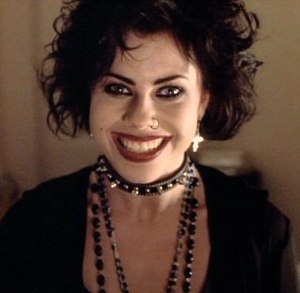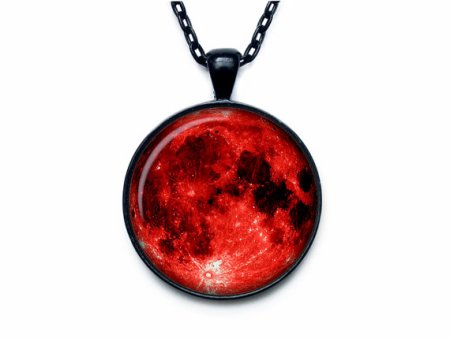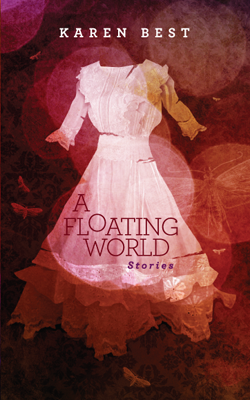Warning: This Post is Full of Spoilers. I Kind of Assume You’ve Seen the Movie Here.
Our first glimpse of Immortan Joe, the Jehovah of Fury Road, is of his elderly, tumor-riddled flesh being encased in the clear armor that gives the illusion of health and strength. Immortan Joe’s cult deals in spectacle, in visual metaphors. It is founded on the male gaze. The masses below jockey to see him in his stone tower. The young, diseased boys that make up his army desire to be seen by Joe; and to be seen going to death in his name by one another. Nux is spurred into a frenzy of action by a glance from Immortan Joe. Similarly, as a War Boy goes to his death, he exhorts his fellows to “witness” the act. The War Boys blacken their eyes; painting a skull over their faces, surrounding the power of the eye with protective darkness. Later, Nux’s fate is sealed when Joe sees him fumble the assassination attempt on Furiosa. As he lies miserably in the back of the War Rig he laments that Joe saw him fail and also saw his own “bloodbag” (Max) driving the rig. Now, he will be denied entrance into Valhalla, an honor only Joe can bestow. It’s the power of the gaze to shape reality, to have effects as demonstrable and yet mysterious as the evil eye that forms a central tenet of the cult Joe builds around himself. After the escape, the vault in which the women are kept is tagged with defiant phrases: “Our babies will not be warlords” and “We are not things.” The words made visible; words that finally enter the eye and cannot be unseen.
Immortan Joe claims people as his property and brands them on the back of the neck with his mark. This is not a placement that reminds the branded as a mark on the hand or face might, it’s a mark to be seen from above, from a remove. A price tag unobtrusively sewn into the back of a garment. Even the “wives” have this mark, underscoring their position as objects not much different from the War Boys. His appearance echoes that of the Sky Gods: long white hair, the eyes piercing and red with wrath, the (plastic, armor) body hard and muscular. (Seriously, when was the last time you saw a skinny Zeus?) His face is obscured by a grinning mask-cum-respirator. He mythologizes himself as the great father. By his hand the people scrabbling in the dust below will be raised up, he preaches. His sons surround him and act out his will. On machines driven by slaves on immense treadmills he is seen to soar into the sky, to the heights of paradise far above the suffering below. He makes water fall from the sky as the Sky Gods do, and withholds it to punish as they also do. He, like the Old Testament patriarchs, keeps multiple “wives” whom he alternately defines as “treasures” and “property.” But Joe is sick and frail. His sons are mutants. His fatherhood creates twisted versions of life. He calls himself immortal when he is clearly doomed by time. His fierce grinning teeth are a facade, and beneath he is an old man, nearly sterile. In the vault where the women were held there is a sterile round pool of water connected to an umbilical stream; the illusion of life with no growth. He sequesters that which he has no right to claim as his: life. The water, the milk that he trades for gas and bullets are taken, hoarded and controlled. He has no power to create, only to take, and then by force.
Furiosa and the women are escaping to a place that has no name, that appears on no maps. It is known only as the Green Place or the Place of the Many Mothers. This place is a shadow place. It exists in Furiosa’s memories as a place of growth, freedom and equality. It is the place she lived in before Immortan Joe claimed her as one of his “things.” Max and Nux, both outcasts from the patriarchal society of the Citadel, find themselves swept along, but it is the women who push forward in search of this feminine space. What they are seeking is an antidote to Immortan Joe, to the warlords and the attitudes that “killed the world.” This place is made of stories and memory and exists in the imaginations of the women. This is the place where they can leave behind the question of who killed the world and find a way to make it live again.
Here an overview of the mythical overtones of the female characters would be helpful. Furiosa’s name contains the Furies within it. The Furies were chthonic deities that enacted vengeance. As chthonic figures, they are associated with the underworld or with residing beneath the earth itself. A theory that resonates with me about chthonic gods claims that these figures descend from a mythology in which the Goddess was the earth itself, and that the immanent, heavy, wet and fertile nature of the earth was a manifestation of the Goddess. The sky, storms, the unseen force of the wind by contrast became the Sky Gods, and eventually, the one and only God. The Goddess absorbed the shadow side of the Sky God. Her ways were not written, not plotted out with clear rules and boundaries. She was murky, formless, unknown, a mystery. She lived in stories and memories that filled in the margins of the Sky God’s mythos. Back to the Furies. Their function is to punish wrongdoers. In the Orestia, the Furies seek vengeance upon Orestes for killing his mother, even though the killing was ordered by Apollo. Initially, I assumed she’d earned her name as one of Joe’s warriors, but later we learn that her name was Furiosa before she was taken. This signals she would always bring a reckoning for Joe’s crimes. The Warlords killed the world. They killed their mother. Vengeance would have to be served.
The unofficial leader of the wives is the heavily pregnant Splendid Angharad. Angharad is a Welsh name that translates as “much loved one,” an ironic reminder that patriarchal values confuse domination with love. She is the mother-goddess, leader and protector of the others. She has convinced the others to go with Furiosa. During one scene, she positions herself so that Joe cannot shoot Furiosa without shooting her. The other women–Toast the Knowing, The Dag, Capable and Cheedo the Fragile–are maiden-figures, though far from naive. They are first shown in filmy garments of virginal white, rinsing themselves in the water from the tanker. The Dag cuts off her chastity belt, spits on it and kicks it with a booted foot. These maidens aren’t interested in playing the helpless innocent virgin. (A reminder that virgin goddesses were not un-sexual, only unattached to a male. Many a virgin goddess has children.) It’s Splendid’s insistence on only killing when utterly necessary that spares Max and Nux. She is the conscience of the group, and her death shakes Cheedo into nearly surrendering herself. It is Splendid who accuses Nux of equal culpability with the Warlords for the state of their world. “We are not things” are Splendid’s words, the women remind each other. Splendid is the one who brings Max water. The mother gives and preserves life. She dies protecting the others. Even the child they remove from her body–the one Immortan Joe falsely claims as his property–is perfect, sheltered from Joe’s corrupting influence as long as it remained part of the mother’s body.
The Vuvalini, Furiosa’s tribe, are the crones in the goddess triad. To reach the Vuvalini, the women have travelled overnight through a barren swamp that supports nothing but crows and inhuman-looking scavengers on stilts. This landscape is the land of the dead. The crows recall the crone’s function as keeper of death. The Celtic crone goddess Morrigan took on the shape of crows. Furiosa’s anguish at learning that the same swamp is what remains of the Green Place is heart-rending. The women have found themselves pushed to the ultimate margin of a dying land. Behind them, a poisoned swamp, before them plains of salt. These are the death-lands they have had to enter to find the crone. The crone goddess holds the keys to death and rebirth. Hecate in the underworld is a crone goddess; a being of dark powers and a forbidding figure of death, a goddess of witches. What she does and rules is hazy. She’s the goddess of the crossroads, where the straight lines of patriarchal society begin to blur. She rules over the spaces between life, death and rebirth. Nux’s incantatory “I live, I die, I live again” is a Sky God’s lie, devised to hide the reality of death. Only the crone knows that rebirth requires annihilation such that “I” is a useless construct. Life goes on, not ego. The Keeper of the Seeds explains to the Dag that she’s killed everyone she met out in the desert. “I thought you girls were above all that,” the Dag replies, searching, perhaps, for an alternative way to the force that gives the Warlords their power. The crone knows that death is a necessity. The Keeper of the Seeds (an epithet that calls to mind other powerful goddesses whose names were not to be invoked: the Kindly Ones or Furies) shows the Dag her bag of seeds, sharing with her the potential for rebirth. When the Dag mentions that she is pregnant, and speculates her child will be another ugly Warlord, it is the Keeper of the Seeds who reminds her that the child could be a girl, offering hope and hinting at the potential for the Vuvalini to persist. The scene in which the two groups of women meet and recognize their common kinship is one of the most beautiful scenes in the movie. The wonder with which the Vuvalini welcome these new daughters is a moment of unalloyed joy. There’s recognition as they pair off and study one another, each seeing their will to survive reflected in the other, exulting in a much-desired female companionship.
Because what the world of Fury Road ultimately needs is to clear away the Sky Gods to make room for Maiden, Mother and Crone. The Vuvalini have dwindled in number in their exile to the borderlands of the psyche, but they hold the keys to rebirth. Their Green Place was poisoned by the same patriarchal logic that killed the world. The Many Mothers have become a handful of woman warriors, prepared now by the infusion of energy from their younger counterparts to stop hiding and start pushing back. As the women observe, everything they need is in the Citadel, and they intend to take it back. Toast’s aside that the Citadel is a great place to live “as long as you aren’t afraid of heights” is the invitation to reclaim divine feminine power that the crones have been waiting for.
As Furiosa tears off Imortan Joe’s mask, revealing the vulnerable flesh under the machinery, her words “Remember me?” are for the crones and for every other facet of feminine power that has been poisoned, marginalized, co-opted or stamped out. Joe’s illusions can’t change the material nature of his body. Even naming himself an immortal can’t erase the effects of time and illness on the matter, the soft, wet meat of his body. Styling himself a Sky God provides no protection from the crone’s processes of decay, erosion and dissolution. Mother, matter, material; all subject to the Goddess in growth or death. Even as The Keeper of the Seeds dies, the Dag—the witchiest of the maidens—saves her seeds and gives her the Vuvalini gesture of reverence for the dead. The Dag takes on the role of Keeper of the Seeds, and in the succession of knowledge from one woman to another, something of the original Keeper lives again. Returning to the Citadel, Furiosa is bloodied and weakened but triumphant as she eventually stands without Max’s help. She stands one-eyed and pierced in the side like Odin, returning a lost power to the world, though not claiming that power as her exclusive right. She has lost her mechanical arm and some of her vision, showing that the Sky God’s powers are not the only ways to be strong. The body of the Father Who Must Be Killed is revealed, for it is only through looking that the power structure Immortan Joe created can understand. The crowd sets upon his human remains and tears them to bits like Maenads. The Venus-of-Willendorf women who provide the milk open taps and the water flows. As the people chant “Lift them up” the women help the people onto the platform, opening the hierarchical sacred space of the tower to all. The crones bring more than seeds; they bring knowledge of other ways to live, a different attitude toward power, the possibility for different structures. They’ve killed the god of domination, objectification and slavery. They’ve balanced the scales for those who killed the world.















